- Home
- Rudy Rucker
White Light (Axoplasm Books)
White Light (Axoplasm Books) Read online
White
Light
by Rudy Rucker
Four Walls Eight Windows
New York/London
Originally published in the U.S. and Canada by Ace Books, 1980.
© 1980 Rudy Rucker.
Published in the United States by:
Four Walls Eight Windows
39 West 14th Street, Room 503
New York, N.Y., 10011
Visit our website at http://www.4W8W.com
First printing April 2001.
All rights reserved. No part of this book may be reproduced, stored in a data base or other retrieval system, or transmitted in any form, by any means, including mechanical, electronic, photocopying, recording, or otherwise, without the prior written permission of the publisher.
Library of Congress Cataloging-in-Publication Data:
Rucker, Rudy v. B. (Rudy von Bitter), 1946-
White Light/Rudy Rucker
p. cm.
ISBN: 1-56858-198-X
I. Title. II. Series: Axoplasm
PS3568.U298W47 2001
813'.54--dc21
95-15079
10 9 8 7 6 5 4 3 2 1
TABLE OF CONTENTS
Foreword
PART 1
In the Graveyard
How I Got This Way
Number of the Beast
Bernco
Donald Duck
Jesus and the Devil
Let the Dead Help You
The Speed of Light
PART 2
Hilbert’s Hotel
What Is Milk?
Epsilon-Zero
The Library of Forms
The Truth
At Alef-One
High Tea
PART 3
Inflatable Love Doll
Urban Terror
Pig Spit
Candy Hearts
Talking Cars
Absolute Zero
PART 4
Halloween
Research
Teaching
The Banach-Tarski Decomposition
Bloody Chiclets
(It’s Never Really) The End
FOREWORD
You now peruse White Light. Better be told now: This 1980 novel is bigger than cyberpunk. This book is transreal.
You can find cyberpunk elements here; you can detect tropes which transferred their heat to cyberpunk. Our protagonist, Felix Rayman, is a rogue mathematician, the kind of guy who calls himself a “head,” who quotes Kerouac and engages in experiments with dreams in an effort to access infinity, who tries to fit his splintered square of a peg into the round hole of a smallish state college somewhere in upper New York state. In short, the dude’s a rogue, he doesn’t fit in. He’s at loggerheads with his beloved wife and feeling guilty about it – we see this in a lot of Rucker books – and though White Light’s hero cheerfully exploits the establishment, he couldn’t care a negatively numbered fig for its values. He wants a redefinition of reality. He’s a goddamn cyberpunk, at least in tone and attitude. Plus, he’s living in a hypertense (and almost hypertext) convergence of information and output. He signifies. He’s heavy with noiselike guitar feedback and he has ever more jittery licks per second than the Ramones. (The first wave of punk rock had just peaked when this book came along.) He’s a fuckin’ cyberpunk, without all the hardware.
Instead of hardware, instead of cyberspace, Felix Rayman has the astral plane. He’s got sets of infinities. He’s got the hypersphere. All of which accesses so very much more than mere cyberspace, as Rucker has always known.
Like the math prof in White Light, Rucker was an assistant professor at a bucolic state college from which he was fired, but he scored a grant and went on to struggle with Georg Cantor’s famous Continuum Problem while he was writing this novel and reading Cantor’s philosophy of math in the original German.
There are drugs in this book, here and there, in more ways than one. Cyberpunk too probably wouldn’t have that faintly hallucinatory sheen around the edges of its dirty chrome fittings if not for drugs. Rucker’s made no secret of the chemical experimentation back in the ’60s and early ’70s that informed some scenes in this book; the white light itself is to some extent a codification of a particular psychedelic experience. We all had different lifestyles back then. But for a real Seeker, drugs are superfluous, or only of passing interest, and so they are for Rudy’s characters, ultimately. Ram Dass said that psychedelics are like a business call: once you get the information, you hang up the phone. If you’re smart.
In the book you now minutely discolor with the effluents on your oily fingers, Rucker found a way to infuse the paradoxical, absurd fantasy of another mathematician, Lewis Carroll, with quantum physics, Einsteinian math theory, and mysticism. In so doing he widened science fiction’s parameters until they shattered; he took some of what Philip K. Dick attempted in A Scanner Darkly – probably an influence on White Light – and he pushed it past the realm of the absurd to the strange place where cartoonlike absurdity interlocks with grim, concrete reality. (Have you noticed how, nowadays, life imitates satire?)
Only the few, the cool, the brave in science fiction really listened: Marc Laidlaw, Paul Di Filippo, Don Webb, a few others, though the honesty and grittiness with which Rucker evokes the Average Guy underlying the Average Scientist might well have influenced certain works by William Gibson and Greg Bear and Bruce Sterling.
But who among the well-known science fiction writers would dare to give us a scene like the one in White Light in which the hero, in an astrally altered state, becomes Donald Duck in a Scrooge McDuck comic, only to have his heart cut out by an Aztec priest? Who would dare a digression this patently ludicrous, this inexplicably touching? Who could successfully carry off such a tour de force…but Rucker?
As for sheer writing, there’s probably no one like him, especially as relates to this particular, and particularly insane, tome. His writing implacably stalks you with a strikingly effective use of plainspoken description, then snares you, yanks you down into shining fissures of poetic otherwheres. The book opens with a quote from Neal Cassady; the Beats and the Merry Pranksters are declaiming in some smoke-filled Dada soiree in a hidden backroom of this novel’s Escherlike corridors of realization.
That’s what this book has: states of realization, each with its own infinitely replicating continuum. It has story, momentum, gripping narrative, but I don’t know if it has a great deal in the way of plot per se. I asked Marc Laidlaw what he thought of this book; he said that when he read this and other Rucker works, he thought at first that the stories, though fascinating, were aimless, unstructured. Then, when he was unable to stop reading, he began to realize: “This guy knows exactly what he’s doing!”
He knows diabolically what he’s doing, all right. Conventional plot isn’t part of the plan. Rucker is declaiming from Transrealism: all of his novels are rooted in Rudy Rucker in some intimate way; each character in some side of Rucker’s own personality, and corresponding to some period in his life (but not necessarily written in that period): The Secret of Life corresponds to 1963–1967; Spacetime Donuts to 1967–1972; White Light to 1972–1978; The Sex Sphere to 1978–1980; The Hacker and the Ants to 1986–1992.
Each novel explores the realizations about life, subjectively and objectively, that Rucker had during those years. And each book is itself a kind of manifesto in prose for Transreal writing. The gist of Transrealism is to be found in Rudy’s anthology, Transreal!; here are selections: “Transrealism writes about immediate perceptions in a fantastic way…. Transrealism tries to treat not only immediate reality, but also the higher reality in which life is embedded…. The characters should be based on actual people. What makes standa
rd genre fiction so insipid is that the characters are so obviously puppets of the author’s will … in a Transrealist novel the author usually appears as an actual character…. If indeed you are writing about immediate perceptions then what point of view other than your own is possible?… The Transrealist artist cannot predict the finished form of his or her work. The Transrealist novel grows organically, like life itself…. Nevertheless, the book must be coherent. A good maze forces the tracer past all the goals in a coherent way…. Transrealism is a revolutionary artform…. Each mind is a reality unto itself. As long as people can be tricked into believing the reality of the 6:30 news, they can be herded about like sheep.”
“My Transreal novels,” Rucker says, “aren’t exactly autobiographical: I have never really left my body and gone to an infinite Heaven, met a sphere from the fourth dimension, infected television with an intelligent virus, etc. But they are autobiographical in that many of the characters are modeled on family and friends – the main person of course being modeled on me. The science fictional ideas in my Transreal fiction have a special role. They stand in for essential psychic events. The quest for infinity, for instance, is nothing other than the soul’s quest for God…. In a nutshell, Transrealism means writing about reality in an honest and objective way, while using the tools of science fiction to stand for deep psychic constructs.”
Honesty is a touchstone of Rucker’s characterization. His rendering of people is painfully, relentlessly, hilariously honest. There’s a Bukowski quality in it, but Bukowski never tried to take his readers up stairways of infinite sets.
Rucker talked intelligently of lucid dreaming and astral projection long before it became New Age fashionable; he worked in weird synchronicities long before Synchronicity became a watchword of the metaphysical counterculture; he spoke of spiritual progress in terms of interfacing a higher intelligence characterized by mathematical purity, a kind of Pythagorean mysticism for the post-Einstein world, in a way that eerily evokes the Hermetic mysteries of millennia past: mysteries in which he was not likely to have been directly initiated.
In White Light Rucker commandingly synthesizes mysticism, pop imagery, the Devil Himself, Jesus Christ, the great mathematicians and their ideas, “head culture,” and even voodoo into a novel that takes us on a wild journey to infinity, to the Absolute, and back again.
A wild ride, people say, about a book like this. Is that all you think it is? Next time you take a trip with Rucker, keep your eyes open.
And remember: though this book truly belongs in the cyberpunk Cortext library, Rudy Rucker has always been bigger than cyberpunk.
Rudy Rucker is Transreal.
JOHN SHIRLEY
El Sobrante, California
WHITE
LIGHT
PART 1
“To have seen a specter isn’t
everything, and there are
death-masks piled, one atop
the other, clear to heaven.”
NEAL CASSADY
No. 1
In the Graueyard
Then it rained for a month. I started smoking again. Noise/ Information… I was outside with a hat on.
Wednesday afternoon, I walked up Center Street to the graveyard on Temple Hill. The rain was keeping the others away, and it was peaceful. I stood under a big twisting tree, a beech with smooth gray hide made smoother by the rain running down it, tucks and puckers in the flesh, doughy on its own time-scale.
In the rain, under the tree in the graveyard, I was thinking about the Continuum Problem. Georg Cantor, father of our country, unearthed it in 1873 and lost his mind trying to solve it.
The light flickered and I could believe that spirits were pressing up to me. Would I sell my soul to solve the Continuum Problem, they wanted to know. Let’s see the solution. Let’s see the soul.
It was hard at first to tell if the deal actually came off. Four years before, I’d had a chance to ask the White Light about the Continuum Problem. It was on Memorial Day during the ’Nam war and there were guys with skinny necks and flags…whew! “And what about the continuum?” I’d asked, serious, pincering up a pencil with triple-jointed fingers. “Relax, you’re not ready,” was the answer – or more the feeling that the Answer was not going to be something I could write down in symbolic logic.
But I’d kept working at it, sharpening my inner eye so I could catch and name most of those bright glimpses…code the idea up in an elegant formulation, a magic spell which could bring the flash back. I was ready in the rain, in the graveyard, hoping to cheat the shades.
There was one stone on Temple Hill I liked particularly. Emily Wadsworth, 1793, epitaph: “Remember that you must die.” I found it refreshing…this welling up of human intelligence, of the reality of existence. I’d first seen the stone a few months earlier, read it, felt happy, but then! A black flyspeck become fly spiralled up from the stone and headed for me, If I land on you, you will die…I ran.
But I was back, there by the beech tree’s flowing trunk, watching the chutes and ladders, the midway of my mind; believing (why not) that the spirits were offering the solution of the Continuum Problem to me. The patterns grew more fantastic, and I hung on, naming them quickly and without sinking, afloat on the rising flood…
The rain has picked up, I realize after a time. I look about for better shelter and pick a small mausoleum near the Wadsworth plot. I hurry over and try the door. Double doors, glass with iron grillwork. One opens, and I go in. There is an ordinary wooden door set into the floor. I tear it off the hinges and run down the staircase. More doors, I throw them behind me. Stairs, doors, black light… I run faster, catching up. Soon I hear the coffin, bumping and groaning down the stairs only a few steps ahead of me, I leap! And land in it, red satin, you understand, a clotted ejaculation…
“But this is not mathematics, Mr…?”
“Rayman. Felix Rayman,” I reply. They are wearing dark suits with vests. Gold watch chains and wingtip shoes. The International Congress of Mathematicians, Paris, 1900.
David Hilbert takes the podium. He’s talking about mathematical problems in general, leading up to his personal list of the top 23 unsolved problems.
He’s little, with a pointed beard and a good speaking style. The first problem on his list is the Continuum Problem, but what catches my attention is the preliminary remark: “If we do not succeed in solving a mathematical problem, the reason frequently consists in our failure to recognize the more general standpoint from which the problem before us appears only as a single link in a chain of related problems.”
I search the crowd for the faces of Klein or Minkowski… I’m sure they’re here. But the faces are indistinct and Hilbert’s German is suddenly incomprehensible. A clod of earth falls on me from the ceiling. I get up and leave.
The exit door gives into a shadowy tunnel. The catacombs of Paris. I walk on, holding a candle, and every twenty paces or so the tunnel branches. I go left, left, right, left, right, right, right, left… My only desire is to avoid falling into a pattern.
Occasionally I pass through small chambers where bones are stored. The monks have built walls out of the thighbones, cords of greasy fuel for the eternal fires; and behind these walls they have thrown the smaller bones. The walls of femurs are decorated with skulls, set into stacks to form patterns – checkerboards, maps, crosses, Latin words. I see my name several times.
Some two thousand branchings into the labyrinth my mind is clear and I can remember every turn I have made. At each branching I am careful to break yet another possible rule for how I am choosing my path. If I continue forever, perhaps I can travel a path for which there is no finite description. And where will I be then? The skulls know.
I blow out my candle and sit in one of Death’s chambers to listen. There is a faint, unpleasant smell and a quiet sifting of dust from the bones’ imperceptible crumbling. In the labyrinth, the city of Death, it is only quiet. “We are sleeping.”
Perhaps I sleep too. It is hard to tell her
e, but it seems that I did complete that infinite journey through the tunnels; that they drew narrower and I more flexible; and that I traveled a path which cannot be described.
As the trip ended I was an electron moving along a nerve fiber, up the spinal cord and into the brain, my brain. It was raining on my face and I tried to sit up. But my body wouldn’t move. It just lay there, cooling in the October rain.
No. 2
How I Got This Way
Being awake in a lifeless body was not an entirely new experience for me. For the last two weeks I had been having strange naps. Naps where I would wake up paralyzed and struggle through layer after layer of illusion before being able to rise. It had all come to a head the day before the graveyard.
I was fresh out of graduate school, and had a job as a mathematics instructor at a state college in Bernco, New York. Some fool or misanthrope had acronymed the college SUCAS. I was the first head to teach at SUCAS, and I felt violently out of place. In the evenings I argued with my wife and listened to the Rolling Stones’ Exile on Main Street on my stereo earphones. In the day I slept on my office floor, asphalt tile soft with 1940’s wax.
Of course it would not do for my so-called students or self-styled colleagues to see me sleeping on the floor, so I locked my door. I slept troubled by the fear that someone would use a passkey to catch me lying there, cheek slick with sleeper’s drool. Frequently my mind would snap awake at the sound of a fist, a key or a claw at my door, and I would have to struggle long minutes to rouse my body.

 Million Mile Road Trip
Million Mile Road Trip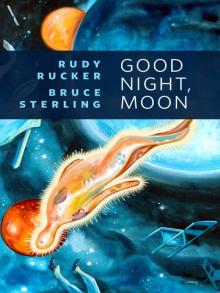 Good Night, Moon
Good Night, Moon Transreal Trilogy: Secret of Life, White Light, Saucer Wisdom
Transreal Trilogy: Secret of Life, White Light, Saucer Wisdom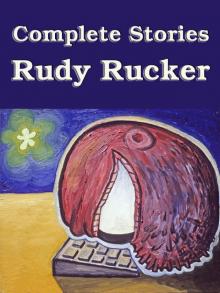 Complete Stories
Complete Stories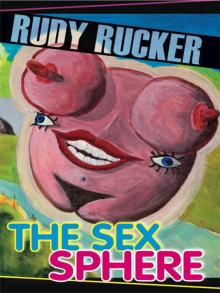 The Sex Sphere
The Sex Sphere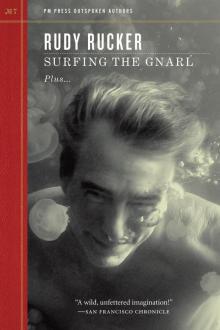 Surfing the Gnarl
Surfing the Gnarl Software
Software Mathematicians in Love
Mathematicians in Love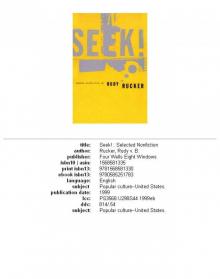 Seek!: Selected Nonfiction
Seek!: Selected Nonfiction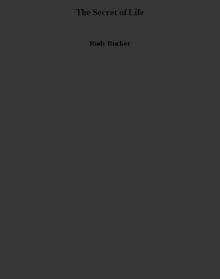 The Secret of Life
The Secret of Life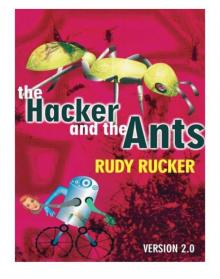 The Hacker and the Ants
The Hacker and the Ants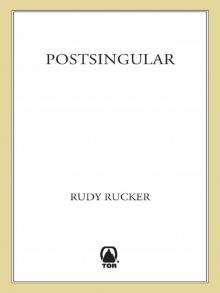 Postsingular
Postsingular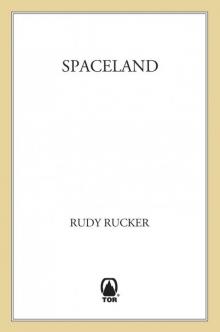 Spaceland
Spaceland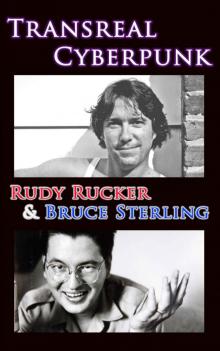 Transreal Cyberpunk
Transreal Cyberpunk Sex Sphere
Sex Sphere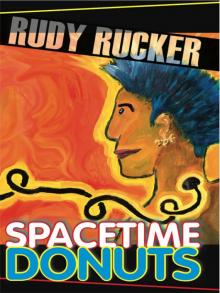 Spacetime Donuts
Spacetime Donuts Freeware
Freeware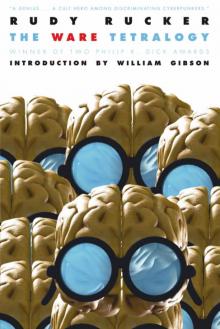 The Ware Tetralogy
The Ware Tetralogy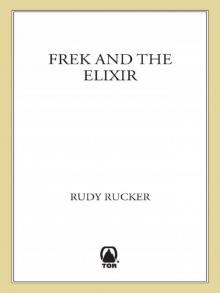 Frek and the Elixir
Frek and the Elixir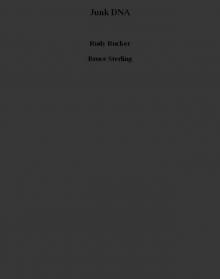 Junk DNA
Junk DNA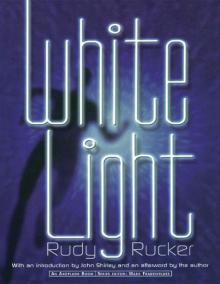 White Light (Axoplasm Books)
White Light (Axoplasm Books)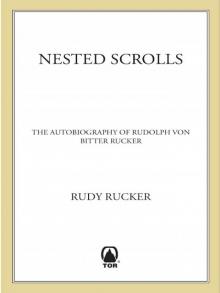 Nested Scrolls
Nested Scrolls Inside Out
Inside Out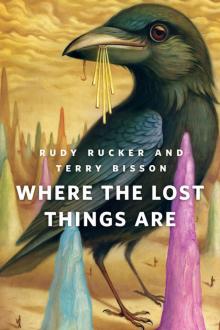 Where the Lost Things Are
Where the Lost Things Are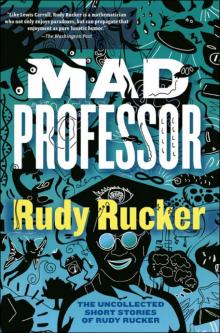 Mad Professor
Mad Professor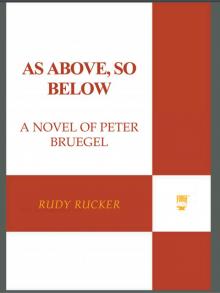 As Above, So Below
As Above, So Below Realware
Realware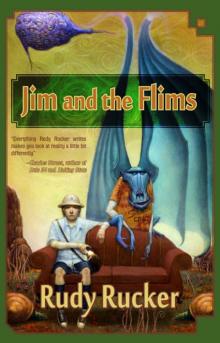 Jim and the Flims
Jim and the Flims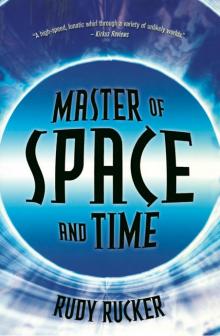 Master of Space and Time
Master of Space and Time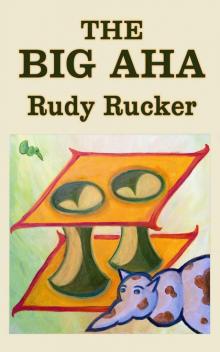 The Big Aha
The Big Aha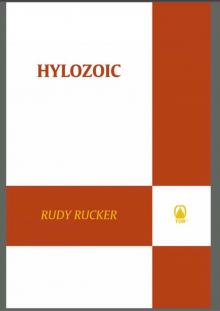 Hylozoic
Hylozoic